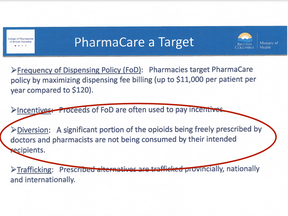British Columbia’s Safer Supply Program Fuels Black Market Opioid Trafficking
British Columbia’s groundbreaking "safer supply" program, designed to combat the opioid crisis by providing pharmaceutical-grade opioids to addicts, is facing intense scrutiny as leaked government documents reveal a significant portion of the supplied drugs are being diverted to the black market. This revelation confirms long-held suspicions of critics and contradicts previous assurances from government officials and health authorities who dismissed such concerns as misinformation. The program, launched in 2020, aims to reduce overdose deaths by providing a safe alternative to contaminated street drugs, thereby connecting users with health and social services. However, the leaked presentation prepared by the B.C. Ministry of Health acknowledges that "significant" quantities of the government-distributed opioids are being trafficked "provincially, nationally and internationally."
The scale of the program is substantial. Between 2022 and 2024, B.C. distributed 19.75 million milligrams of hydromorphone, equivalent to approximately 2.5 million 8mg pills, and 1.4 million mg of oxycodone, equivalent to about 70,000 20mg pills. Critics had warned from the outset that the program could inadvertently fuel the black market, as addicts might sell their rations to purchase illicit substances. This concern materialized as “safer supply” pills began appearing in drug busts and online marketplaces. Anecdotal evidence also emerged, with reports of open transactions outside pharmacies dispensing the prescribed opioids. The leaked document has ignited a political firestorm, with the opposition B.C. Conservatives accusing the government of “taxpayer-funded drug trafficking.”
While B.C. Health Minister Josie Osborne acknowledged the diversion problem, she emphasized the government’s commitment to addressing the issue. However, this admission contrasts sharply with previous statements from government officials and health authorities. Provincial Health Officer Bonnie Henry, in a 2023 report recommending an expansion of the program, downplayed diversion, attributing it to “unmet needs.” Similarly, B.C. Solicitor General Mike Farnworth had denied widespread diversion, while advocacy groups and researchers dismissed concerns as exaggerated and politically motivated. The debate surrounding safer supply highlights a complex dilemma: balancing the need to reduce harm among vulnerable populations with the risk of unintended consequences, such as black market proliferation.
The B.C. government’s primary defense against diversion criticisms relied on autopsy data, which showed that “safer supply” opioids were not appearing in significant quantities in overdose victims. Then-chief coroner Lisa Lapointe cited this as evidence against diversion, although this data did not address the percentage of safer supply reaching intended users or the rates of hydromorphone addiction. This reliance on limited data points created a blind spot in assessing the program’s effectiveness and its potential contribution to the black market. The leaked document forces a reevaluation of the safer supply program and its impact.
The ongoing opioid crisis in B.C. continues to claim lives at an alarming rate. Despite the government’s efforts, approximately 200 people per month were dying from overdoses during the period in question. The revelation of significant diversion raises serious questions about the efficacy of the safer supply program and its unintended consequences. The government’s acknowledgement of the problem, coupled with the mounting evidence, necessitates a comprehensive review of the program’s implementation and oversight mechanisms. Moving forward, a more balanced approach is needed, one that considers the complex interplay of harm reduction, addiction treatment, and law enforcement efforts.
Beyond the safer supply controversy, other news highlights the challenges Canada faces in addressing drug-related issues. An agreement with the Trump administration averted threatened tariffs in exchange for increased border security measures to combat fentanyl smuggling and illegal migration. However, critics argue that the focus on physical border patrols is less effective than targeting fentanyl production labs. Furthermore, limitations on the powers of provincial officers deputized for border patrol raise concerns about the efficacy of these measures. These events underscore the complex and multifaceted nature of the drug crisis and the need for comprehensive strategies that address both supply and demand-side factors.


